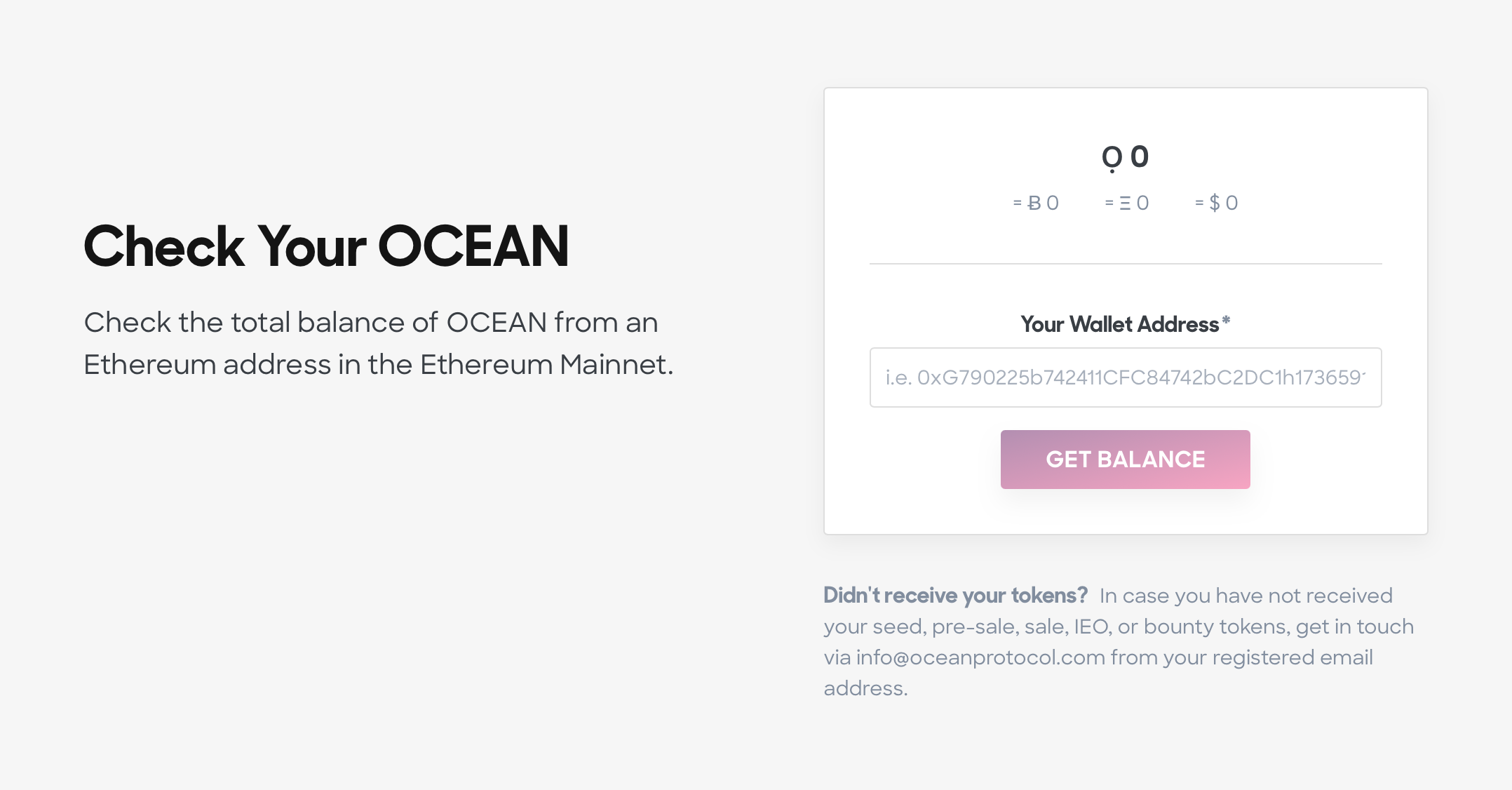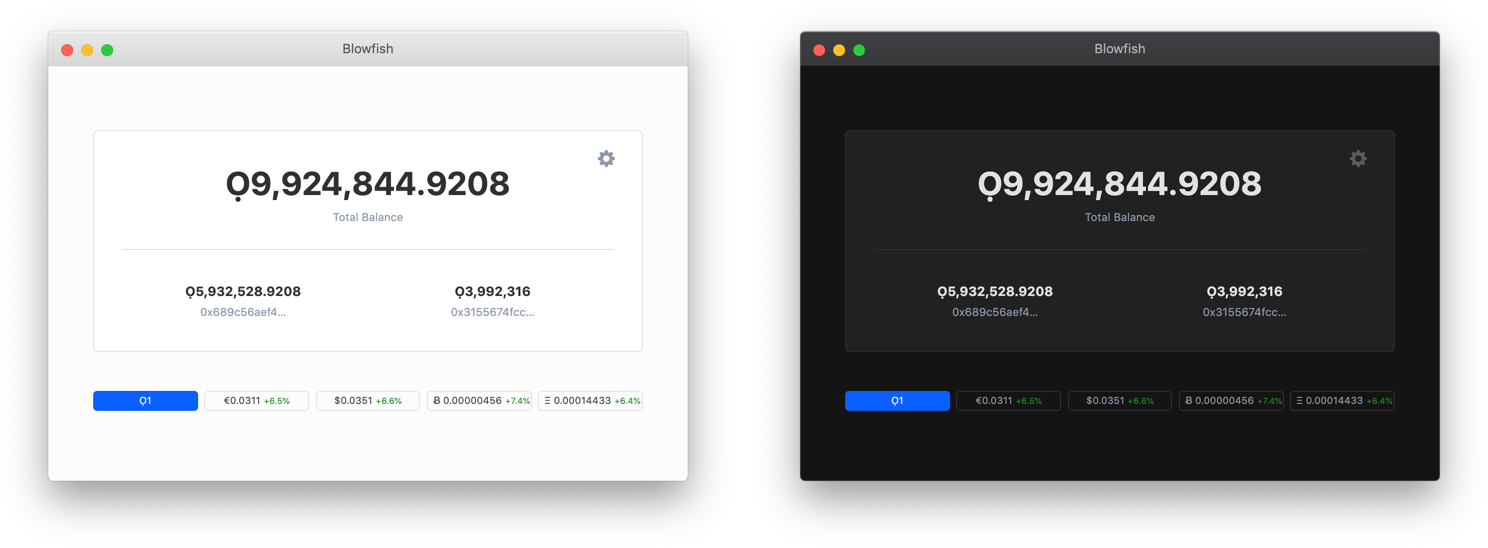8.5 KiB
| title | description |
|---|---|
| Ocean Tokens | The technical basics and most important infos about Ocean Tokens in different networks. |
Basics
Ocean Tokens are the cryptocurrency associated with Ocean Protocol. They are standards-compliant ERC-20 tokens.
Ocean Tokens can, in principle, live in any EVM-compatible network. The Ocean Token contract is deployed in the Ethereum Mainnet, Pacific Mainnet, and the Nile Testnet.
Only OCEAN within the Ethereum Mainnet carry any value, reflected on our token page.
| Property | Value |
|---|---|
| Token Contract Addresses | Ethereum Mainnet0x967da4048cD07aB37855c090aAF366e4ce1b9F48Pacific Mainnet 0x012578f9381e876A9E2a9111Dfd436FF91A451aeNile Testnet 0x9861Da395d7da984D5E8C712c2EDE44b41F777Ad |
| Token Symbol | OCEAN |
| Decimals of Precision | 18 |
Ethereum Mainnet Ocean Tokens
There were several ways to acquire some of the Ethereum Mainnet Ocean Tokens in the initial circulating supply, including:
- participation in the seed round
- participation in the pre-sale
- participation in the token sale
- participation in the initial exchange offering (IEO)
- completion of a bounty
After the initial exchange offering on Bittrex International, Ethereum Mainnet Ocean Tokens became available in the Ethereum Mainnet (and not in any other network).
The initial circulating supply of Ethereum Mainnet Ocean Tokens became available on the Ethereum Mainnet in May 2019. If you acquired Ocean Tokens in the initial circulating supply, they should have been, or will be, sent to the address you provided, in the Ethereum Mainnet.
At the time of writing, you could use Ethereum Mainnet Ocean Tokens to do various things in the Ethereum Mainnet, including but not limited to:
- buy other cryptocurrencies
- provide liquidity in decentralized exchanges like Uniswap or Balancer
Check Your Ethereum Mainnet Ocean Token Balance
There are many ways to check your Ethereum Mainnet Ocean Token balance. Starting with the easiest, here are some ways:
Ocean Token Tool
Enter your account address into the form on the Ocean Token page on our website.
Blowfish
Download and use Blowfish, a desktop app that tells you your Ocean Token balance (and other things).
MetaMask
Use MetaMask or other ERC-20-compatible wallet software. See the page about using wallet software to manage Ocean Tokens. You can also use wallet software to send Ocean Tokens to some other account.
Etherscan
Go to Etherscan, enter your account address into the search field, click Search, click on Erc20 Token Txns, look for an OceanToken transaction in the Token colum, and click on OceanToken there.
Buy or Sell Ethereum Mainnet Ocean Tokens
You can buy or sell Ethereum Mainnet Ocean Tokens (OCEAN) via any exchange that lists them. An always up-to-date official list of exchanges can be found on the Ocean Token page on our website.
Pacific Network Ocean Tokens
Ocean Tokens in Ocean's Mainnet, Pacific, represent the same value as in the Ethereum Mainnet. The only way to get Ocean Tokens in Pacific is to transfer them from the Ethereum Mainnet.
Testnet Ocean Tokens
There are Ocean Tokens in several testnets, including the Nile testnet. They are just testnet Ocean Tokens (i.e. for testing purposes only) and they aren't interchangeable with Ethereum Mainnet Ocean Tokens. For more details, see the the page about Testnets and the tutorials.
Once you have some Testnet Ocean Tokens, you can use them for all currently-implemented Ocean Protocol tasks in that testnet (e.g. buying assets).
Get Testnet Ocean Tokens
All Squid libraries have methods to request Ocean Tokens. They work by calling the Dispenser keeper contract, a contract which is only deployed to testnets. Therefore they will only work in testnets.
They're documented in the following places:
- The squid-js docs for:
- The squid-py docs for:
- the
squid_py.ocean.ocean_tokensmodule: see therequest()method. - the
squid_py.ocean.ocean_accountsmodule: see therequest_tokens()method.
- the
- The squid-java docs: click All Classes then AccountsManager then scroll to the bottom of the Class AccountsManager page where you'll find the
requestTokens()method.
The Example Code page has links to example Squid code (in all of the languages), including examples of using the above methods.

